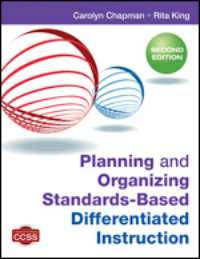Developing a Game Plan for Differentiated Instruction
Planning and Organizing Standards-Based Differentiated Instruction (2nd Edition)
By Carolyn Chapman and Rita King
(Corwin, 2014 – Learn more)

Differentiated instruction is a term that many educators have heard. However, many teachers are still not implementing this core strategy in their classroom instruction. There are many reasons for this, as Carolyn Chapman and Rita King discuss in their newly revised book, Planning and Organizing Standards-Based Differentiated Instruction (2nd Edition).

- Differentiated Learning Environment
- Differentiated Formative Assessment
- Differentiated Instructional Strategies
- Flexible Grouping Strategies
- Planning with Differentiated Models
- Planning for Standards with Differentiated Instruction
Even though this book is directed toward teaching educators how to differentiate instruction, it is also focused on building a sense of community where all stakeholders are working together to meet the needs of ALL students and where success, no matter how small, is showcased. In that spirit, they also seek to help administrators understand the principles of differentiation so they can better help their staff as they grow into this higher level of teaching practice.
The authors continuously encourage the use of professional development and support. They place emphasis on strong leadership that monitors teachers’ progress through meetings, observations, and workshops as they become more efficient in differentiating instruction. To help with this, the final section of the book provides multiple ways that leadership teams can help teachers with differentiating instruction by providing professional development plans, ideas, and templates that can be used for observations and self-reflection.
Among the new content in the 2nd Edition are:
- Classroom management strategies customized for learners in all grade levels.
- Strategies to transition into and out of flexible groupings.
- Customized approaches for working with shy and nervous students, impatient students and turned-off students.
- Tips on clear communications with diverse students and their parents.
- New ready-to-use tools, agendas, organizers, checklists, and more.
As a whole, the text is very well written and had numerous ideas and templates for educators and leadership faculty to use right away in their classrooms. The only criticism I have: there are errors in the text that direct the reader to incorrect or non-existent page numbers (perhaps they refer to the first edition and were overlooked in the editing).
That being said, I still highly recommend Planning and Organizing Standards-Based Differentiated Instruction, which offers a clear path to reaching a challenging goal. It is useful to classroom teachers, leadership faculty, and educators in general and full of information on how to meet the needs of all students.
The book also matches instructional strategies to standards required by various states, including the Common Core. As a college-based teacher educator, I plan on using this book when teaching prospective teachers because of the easy-to-follow format and explanations.
Casey Gilewski is from Memphis TN and is currently a doctoral student and graduate teaching assistant. She has taught in public schools for six years – one year in second grade, five in sixth, and two in seventh and eighth. Throughout her public school experience, she has taught English language arts and special education and has served as grade chair and on Common Core committees. Her doctoral dissertation focuses on differentiated instruction and assessment.



































